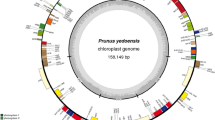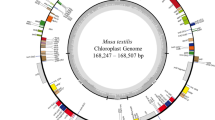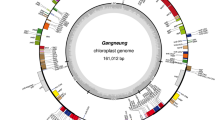Abstract
Gene-based markers are useful tools for genetic background surveys and comparative genome analysis due to their ease of application across closely related species. We developed gene-based DNA markers for Phalaenopsis ‘KS Little Gem’, a new Phalaenopsis variety with excellent ornamental traits, based on a genome-wide comparison of chloroplast and nuclear sequences with those of orchids as well as monocot species, including rice and banana, to establish a molecular basis for species identification. Sequence comparisons of chloroplast DNA from P. ‘KS Little Gem’ with those of P. aphrodite and P. equestris identified six variable genic regions of the chloroplast genome in which an intron of rpl16 was the most polymorphic between related orchid species. To develop conserved ortholog set (COS) markers, we compared transcriptome unigenes of P. ‘KS Little Gem’ with the P. equestris, rice, and banana genomes and identified 582 Phalaenopsis COS candidates with at least two exons. PCR application using primer sets targeting six variable regions of the chloroplast genome and introns of 45 randomly selected COS candidate genes showed 92-98% amplification in three Phalaenopsis species. Among the candidate genes, we developed rpl16 and three COS genes as diagnostic cross-species markers for P. ‘KS Little Gem’ and diverse, related orchids. The gene-based molecular markers developed in this study will play an important role in species identification to facilitate the protection of P. ‘KS Little Gem’ variety rights, as well as breeding and genetic studies of Phalaenopsis orchids.
Similar content being viewed by others
Literature Cited
Altschul S, Madden T, Schaffer A, Zhang J, Zhang Z, Miller W, Lipman D (1997) Gapped BLAST and PSI-BLAST: a new generation of protein database search programs. Nucleic Acids Res 25:3389–3402
Atwood J, Jr. (1986) The size of Orchidaceae and the systematic distribution of epiphytic orchids. Selbyana 9:171–186
Bushakra J, Sargent D, Cabrera A, Crowhurst R, Girona E, Velasco R, Symonds V, Knaap E, Troggio M, et al (2011) Rosaceae conserved orthologous set (RosCOS) markers as a tool to assess genome synteny between Malus and Fragaria. Tree Genet Genomes 8:643–658
Cabrera A, Kozik A, Howad W, Arus P, Iezzoni A, van der Knaap E (2009) Development and bin mapping of a Rosaceae Conserved Ortholog Set (COS) of markers. BMC Genomics 10:562
Cai J, Liu X, Vanneste K, Proost S, Tsai W, Liu K, Chen L, He Y, Xu Q, et al (2014) The genome sequence of the orchid Phalaenopsis equestris. Nat Genet 47:65–72
Chapman M, Chang J, Weisman D, Kesseli R, Burke J (2007) Universal markers for comparative mapping and phylogenetic analysis in the Asteraceae (Compositae). Theor Appl Genet 115:747–755
D’Hont A, Denoeud F, Aury J, Baurens F, Carreel F, Garsmeur O, Noel B, Bocs S, Droc G, et al (2012) The banana (Musa acuminata) genome and the evolution of monocotyledonous plants. Nature 488:213–217
De Riek J (2001) Are molecular markers strengthening plant variety registration and protection? Acta Hortic 552:215–223
Fulton T, Van der Hoeven R, Eannetta N, Tanksley S (2002) Identification, analysis, and utilization of conserved ortholog set markers for comparative genomics in higher plants. Plant Cell 14:1457–1467
Grabherr M, Haas B, Yassour M, Levin J, Thompson D, Amit I, Adiconis X, Fan L, Raychowdhury R, et al (2011) Full-length transcriptome assembly from RNA-seq data without a reference genome. Nat Biotechnol 29:644–652
Hollingsworth P, Graham S, Little D (2011) Choosing and using a plant DNA barcode. PLoS ONE 6:e19254
International Rice Genome Sequencing Project (2005) The map-based sequence of the rice genome. Nature 436:793–800
International Trad Centre (2016) Trade statistics for international business development. Available via http://trademap.org/index.aspx/. Accessed 1 May 2016
Jeong Y-M, Chung W-H, Chung H, Kim N, Park B-S, Lim K-B, Yu H-J, Mun J-H (2014) Comparative analysis of the radish genome based on a Conserved Ortholog Set (COS) of Brassica. Theor Appl Genet 127:1975–1989
Kelchner S (2002) Group II introns as phylogenetic tools: structure, function, and evolutionary constraints. Am J Bot 89:1651–1669
Kim G-B, Kwon Y, Yu H-J, Lim K-B, Seo J-H, Mun J-H (2016) The complete chloroplast genome of Phalaenopsis "Tiny Star". Mitochondrial DNA 27:1300–1302
Krutovsky K, Troggio M, Brown G, Jermstad K, Neale D (2004) Comparative mapping in the Pinaceae. Genetics 168:447–461
Larkin M, Blackshields G, Brown N, Chenna R, McGettigan P, McWilliam H, Valentin F, Wallace I, Wilm A, et al (2007) Clustal W and Clustal X version 2.0. Bioinformatics 23:2947–2948
Liewlaksaneeyanawin C, Zhuang J, Tang M, Farzaneh N, Lueng G, Cullis C, Findlay S, Ritland C, Bohlmann J, et al (2008) Identification of COS markers in the Pinaceae. Tree Genet Genomes 5:247–255
Lin B-Y, Chang C-D, Huang L, Liu Y-C, Su Y-Y, Chen T-C, Lee R-H, Huang H-J, Wu W-L, et al (2015a) The mitochondrial DNA markers for distinguishing Phalaenopsis species and revealing maternal phylogeny. Biol Plant 60:68–78
Lin J-Y, Lin B-Y, Chang C-D, Liao S-C, Liu Y-C, Wu W-L, Chang C-C (2015b) Evaluation of chloroplast DNA markers for distinguishing Phalaenopsis species. Sci Hortic 192:302–310
Luo R, Liu B, Xie Y, Li Z, Huang W, Yuan J, He G, Chen Y, Pan Q, et al (2012) SOAPdenovo2:an empirically improved memory-efficient short-read de novo assembler. GigaScience 1:18
Padolina J, Linder C, Simpson B (2005) A phylogeny of Phalaenopsis using multiple chloroplast markers. Selbyana 26:23–27
Quraishi U, Abrouk M, Bolot S, Pont C, Throude M, Guilhot N, Confolent C, Bortolini F, Praud S, et al (2009) Genomics in cereals: from genome-wide conserved orthologous set (COS) sequences to candidate genes for trait dissection. Funct Integr Genomics 9:473–484
Schnable P, Ware D, Fulton R, Stein J, Wei F, Pasternak S, Liang C, Zhang J, Fulton L, et al (2009) The B73 maize genome: complexity, diversity, and dynamics. Science 326:1112–1115
Timms L, Jimenez R, Chase M, Lavelle D, McHale L, Kozik A, Lai Z, Heesacker A, Knapp S, et al (2006) Analyses of synteny between Arabidopsis thaliana and species in the Asteraceae reveal a complex network of small syntenic segments and major chromosomal rearrangements. Genetics 173:2227–2235
Tsai C, Huang S, Chou C (2006) Molecular phylogeny of Phalaenopsis Blume (Orchidaceae) based on the internal transcribed spacer of the nuclear ribosomal DNA. Plant Syst Evol 256:1–16
Wu F, Mueller L, Crouzillat D, Petiard V, Tanksley S (2006) Combining bioinformatics and phylogenetics to identify large sets of single-copy orthologous genes (COSII) for comparative, evolutionary and systematic studies: a test case in the euasterid plant clade. Genetics 174:1407–1420
Author information
Authors and Affiliations
Corresponding author
Additional information
These authors are contributed equally to this work.
Rights and permissions
About this article
Cite this article
Kwon, YE., Yu, HJ., Baek, S. et al. Development of gene-based identification markers for Phalaenopsis ‘KS Little Gem’ based on comparative genome analysis. Hortic. Environ. Biotechnol. 58, 162–169 (2017). https://doi.org/10.1007/s13580-017-0189-y
Received:
Revised:
Accepted:
Published:
Issue Date:
DOI: https://doi.org/10.1007/s13580-017-0189-y




